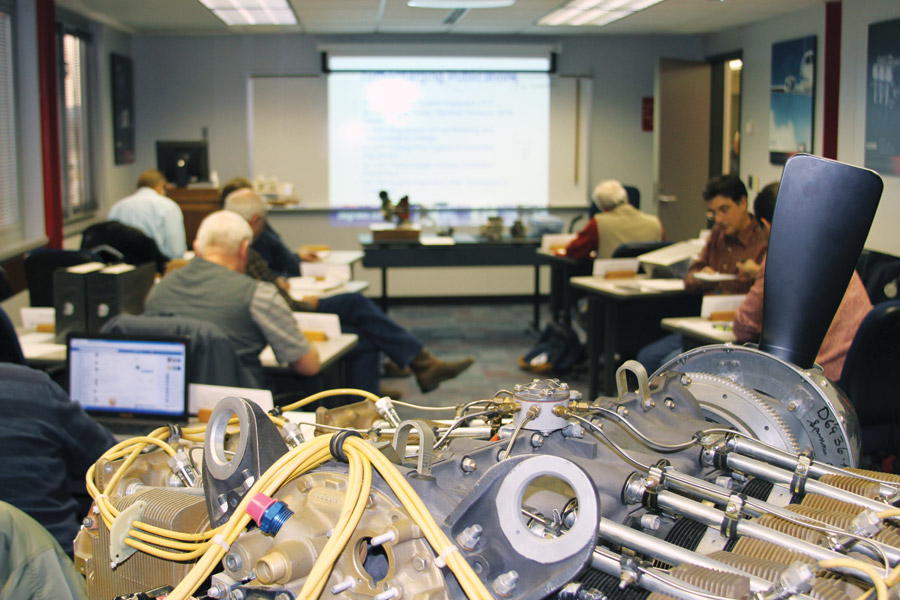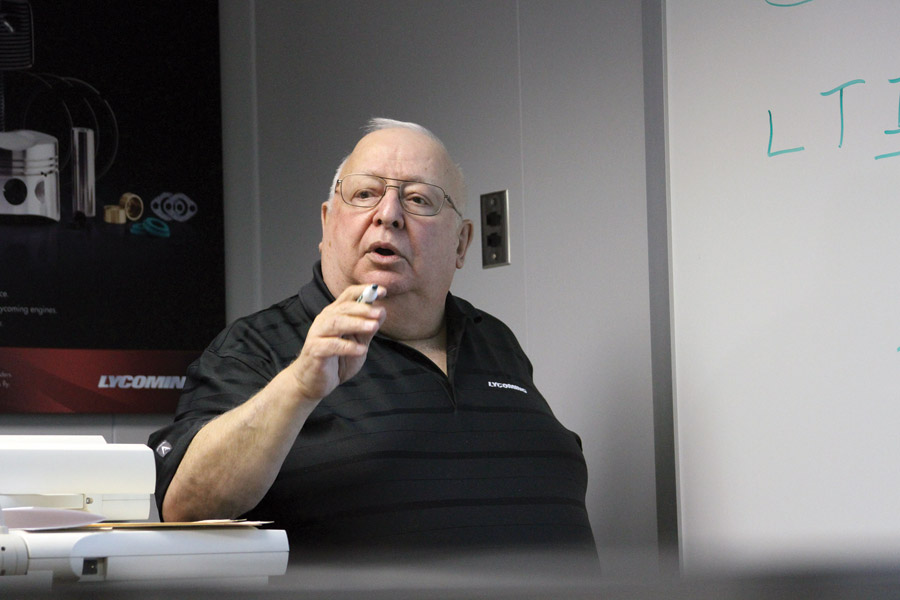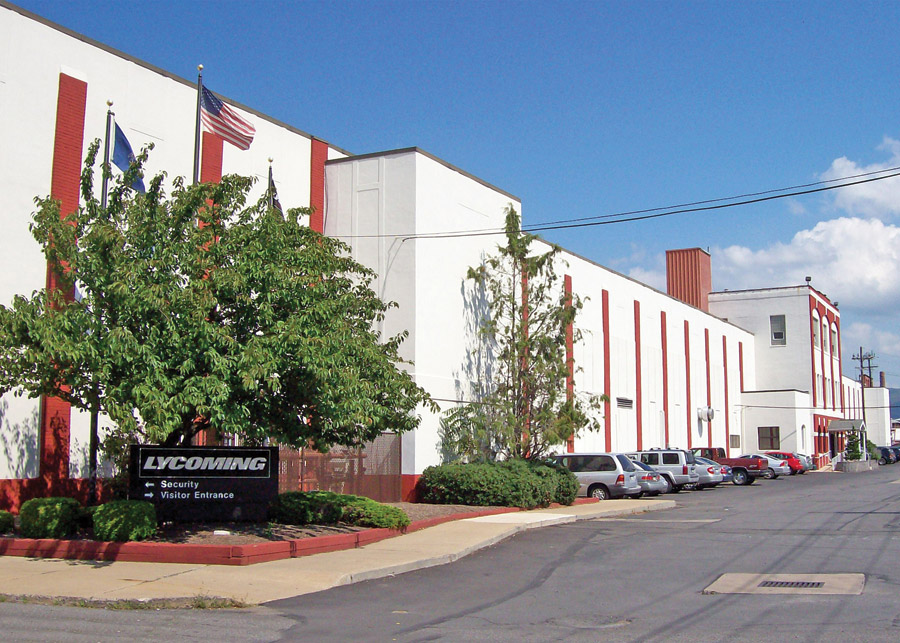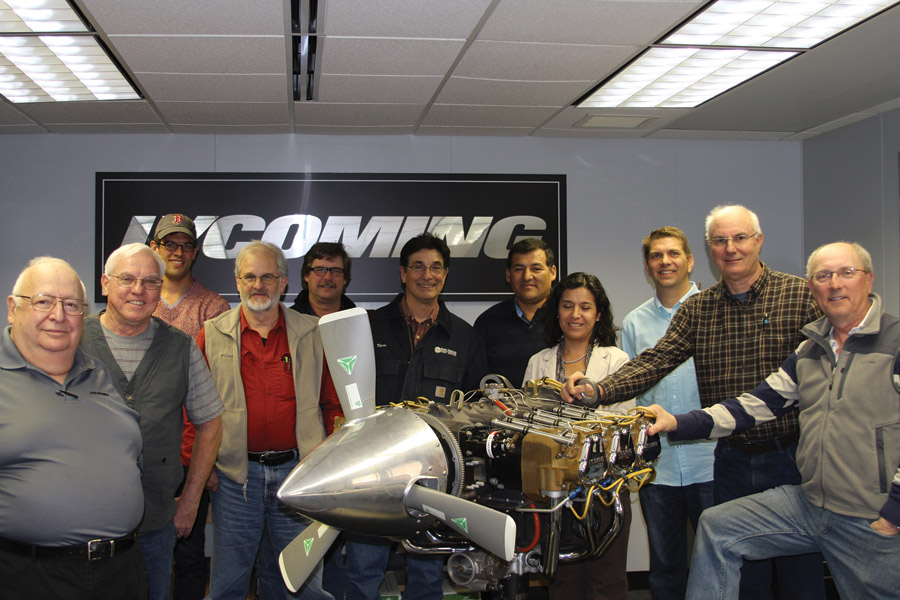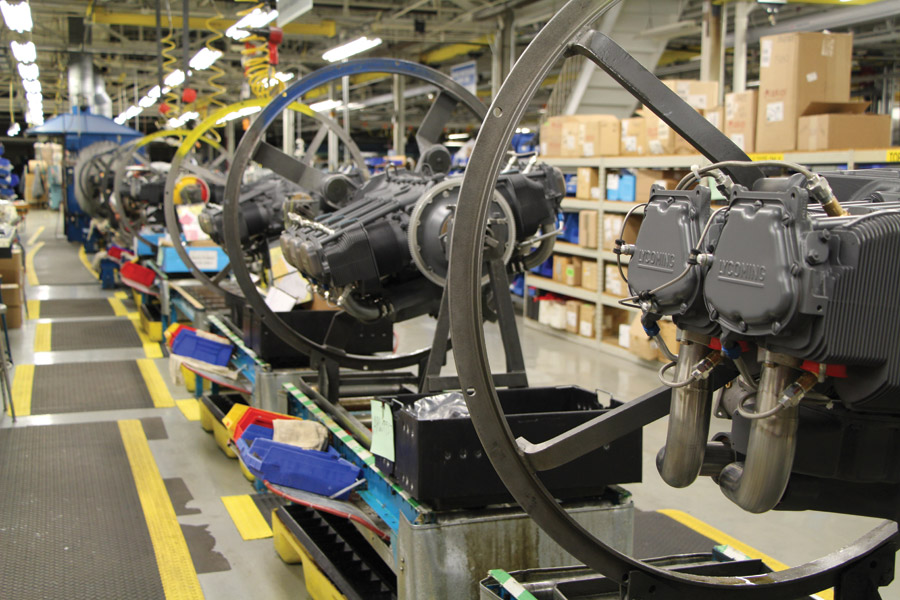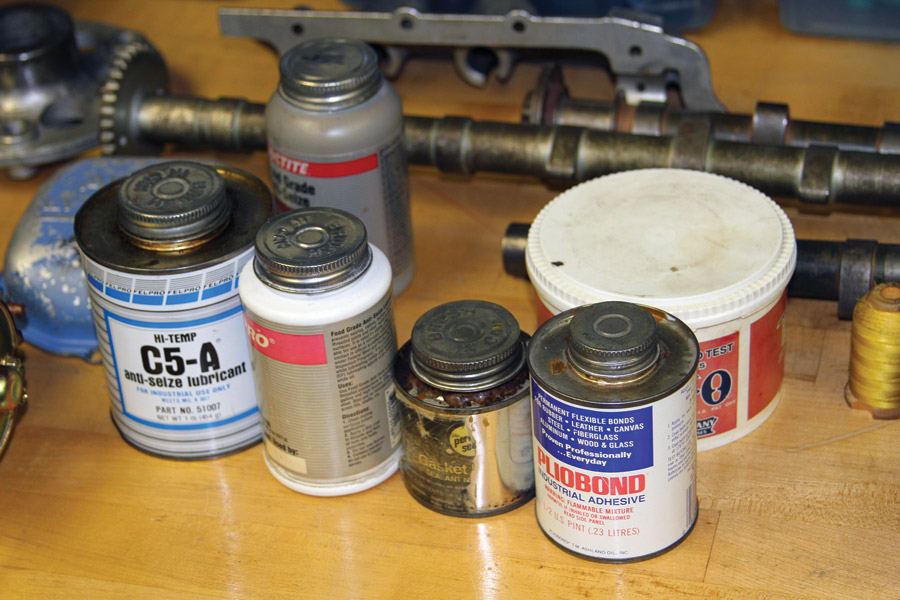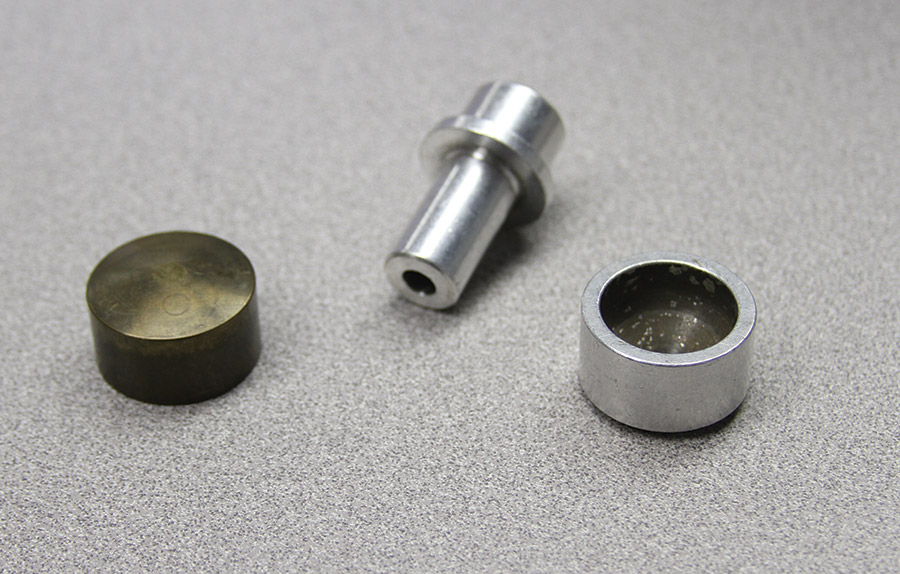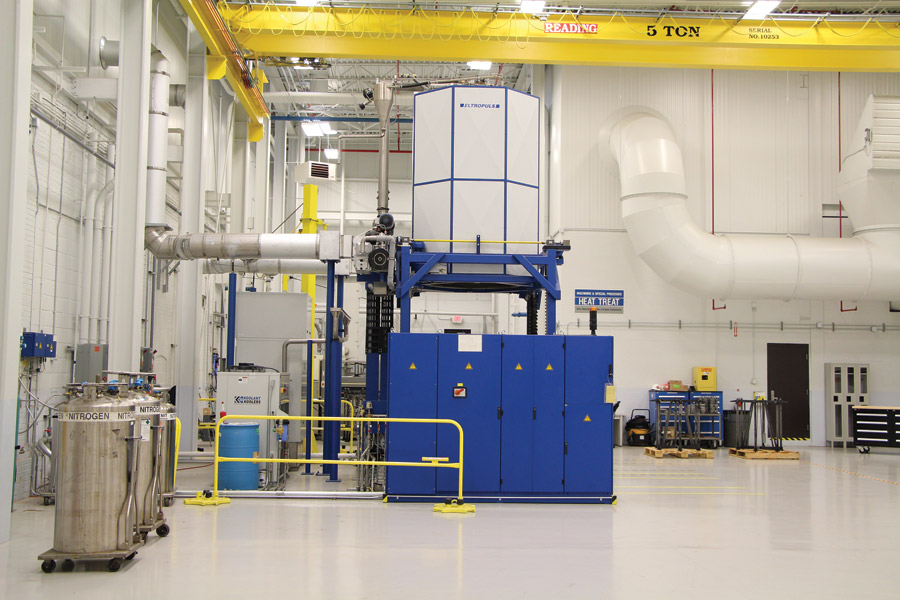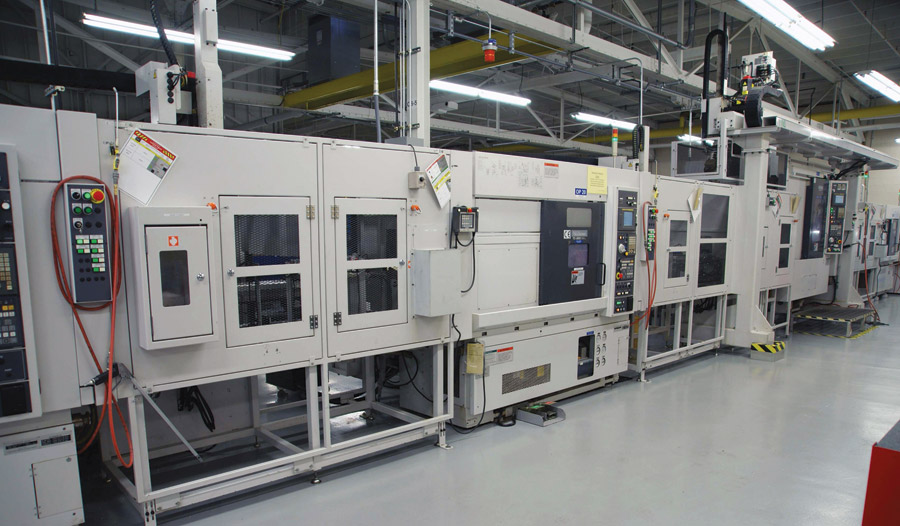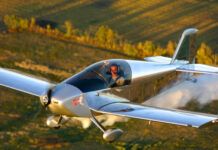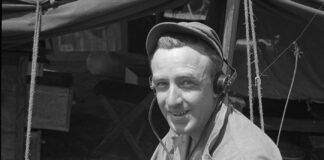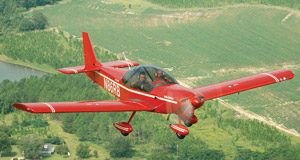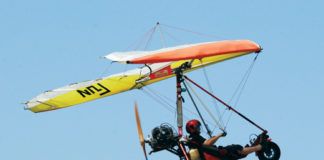The town of Williamsport, Pennsylvania, is located near a stream that the indigenous Lenape people called Legani-hanne, which means “sandy stream.” The name was later spoken and recorded by European settlers as Lycaumick, and that morphed into a word known by many generations of pilots—Lycoming. Williamsport is not only the seat of government for Lycoming County, but the home of Lycoming engines and other small industries. Located in central Pennsylvania, just a little ways upstream from Lock Haven (the traditional home of Piper Aircraft), the name is pronounced by locals as “Lycumming”—a bit strange to this long-time aviator’s ear, but not unpleasant at all.
Instructor Jim Doebler loves to tell stories from his career working on Lycoming engines. Doebler planned to retire in May 2016.
I came to this land of hills, woods, and streams in the dead of winter to buckle down for some good old fashioned schooling—schooling in the proper ways to maintain, disassemble, and re-assemble the ubiquitous Lycoming aircraft engine. The school, run cooperatively by Lycoming Engines and the Pennsylvania College of Technology, is well known as the place to go for mechanics, pilots, and anyone else who needs to know the intricacies of the gray powerplants that hang on the noses and nacelles of so many airplanes.
The Lycoming factory has been around for close to a century, and has seen as many as 3000 new engines produced in a month. Today the numbers are smaller, but the old building still serves well.
Lycoming began its corporate life building sewing machines and bicycles before getting its start in engines. They have built powerplants for cars and tanks, as well as airplanes, and it is often forgotten that in addition to the well-known horizontally opposed piston powerplants, they also built radials and even turbines. While they continue to support all of the products that they have built and certified, their work today is almost entirely on gasoline piston engines—with a few projects devoted to drone engines and other advanced designs. The majority of their work is building up new and remanufactured “stock” engines for certified and Experimental use, but they have an entire assembly area dedicated to the Thunderbolt line of custom, high-powered Experimental powerplants used by airshow performers and racing pilots.
The typical class has a mix of students with different backgrounds, but all share the need and desire to learn more about Lycoming engines.
One of the benefits of visiting Williamsport for the school is the opportunity to tour the Lycoming plant itself. Even though the course is sometimes taught elsewhere around the country (and around the world), seeing where and how our engines are made, and the attention to detail observed by the workers in the plant, is worth the travel. The Lycoming facility is still in its original location from a century before, and while it has grown over the years, much of the building dates back to those original days. During the heyday of general aviation, they reportedly built close to 3000 engines per month, running five assembly lines for the five major types of engines they produced. Today, the factory puts out closer to 3000 powerplants per year, giving the feel of a much smaller custom shop living within a huge space. But it is evident that every employee in the factory knows the critical nature of what these engines will do, and care is put into every step. There are, in fact, large signs on the walls in several locations saying “Build every engine as if you were going to fly behind it!”
Lycoming Service Class
There are actually two separate classes available to mechanics and pilots as part of the curriculum offed by the partnership: The first is the Lycoming Service Class and lasts four days. The second, Engine Disassembly and Reassembly, is scheduled for three days immediately after the first. In our case, the two classes were scheduled with a weekend in between, giving us a chance to study material from the first before diving into the second. We’ll talk about the Disassembly and Reassembly class next time. For now, we’ll concentrate on the Service class. Both are held in the comfortable classrooms of the technical college located at the Williamsport Airport (KIPT), a couple of miles east of downtown. The sleepy little town of Montoursville has a number of nice cafs and restaurants where students can find a quick, inexpensive lunch, and it never hurts to take classes at an airport, where students can see aviation being committed on a regular basis.
Engines that have passed their run-in line up on the “trim line” where all final accessories are installed, scratches are cleaned up, and the engines are made ready for shipping.
The Service class is designed to teach students as much as they can learn about how Lycoming engines are designed, manufactured, and maintained. The four days of lecture pass quickly, as veteran instructor Jim Doebler passes around hardware just as readily as he dispenses stories of his many decades as a Lycoming service rep, mechanic, and A&P instructor. Doebler has traveled the world to dispense this information to mechanics in many different countries, but it is clear that he likes to teach in his own classroom, with his many boxes of assorted parts and assemblies to use as examples.
The first thing that students do when they arrive is to fill out an order form that entitles them to a complete set of Lycoming service letters, bulletins, and instructions—to be sent to their home or business. It’s a good thing that they aren’t expected to carry them home; the classroom versions occupy two 6-inch thick binders and weigh in at an impressive poundage. The material is included in the course fee and provides update service for a year, at which time the student can decide to renew or not. According to Doebler, there has been talk of going all electronic for most of Lycoming’s documentation for years, but so far that hasn’t happened, and that means that paper documents are still handy to have around.
Certification breeds paperwork, and that paperwork tells us how each engine should be maintained to keep it in accordance with the manufacturer’s instruction. As Lycoming frequently points out, the Experimental world does not have the same legal requirement for maintenance to factory standards—but the engine itself doesn’t know if it is installed in a certified or Experimental aircraft, so good judgment means that instructions and directives from the factory should always be considered by homebuilders when maintaining their engines.
Once registration paperwork was out of the way, Doebler dove straight into the course material, first talking about—the paperwork. Service bulletins, ADs, instructions, and letters were all discussed with regards to their importance and relevance to different kinds of operators. The class leaves one with a good understanding of the place all of these have in the maintenance of a Lycoming engine and how to find the information that you need when determining, for instance, the torque on a specific bolt while assembling an engine or component.
One of the key elements to proper assembly and maintenance of a Lycoming is to use proper sealants and lubricants. The service class not only teaches what should be used, but why they should be used.
Beyond Paperwork
Following the documentation briefing, the real meat of the course began and lasted for the rest of the days. Doebler’s descriptions of how individual components are manufactured and how the various machining and plating processes are performed gives one a better understanding of why parts are shaped the way they are, and more importantly, why some surfaces can be re-machined and others are hardened or coated in a way that they cannot be re-done. Many of the manufacturing processes are designed to produce extremely hard or wear-resistant components that should last through several overhaul periods, so long as foreign objects are not allowed to wear them away.
As each component is covered in turn, the class goes into not only the manufacturing process, but the maintenance procedures related to it, the problems that might be encountered in the life of the component, and various tips and tricks that will help maintain and get the longest life out of the component. Relevant service documents are introduced for the students to study for further information, and Doebler concludes each segment with real-world stories of issues he (and other service reps) have encountered over the years.
The history of various parts is important; here are three different versions of piston pin plugs. All three (and the reasons behind them) were discussed in the course, along with their pros and cons.
Because Lycoming has built over 750 different models of engines (with variations between models sometimes coming down to the size of the prop bolt bushings), engines are covered in general terms, but specific models of note—such as the 76 Series engines (the infamous “H” models) feature prominently in stories. Not surprisingly, most stories have happy endings, as Lycoming has always stepped up and fixed issues faced by customers around the globe. The O-320-H2AD, for instance, was produced specifically for the Cessna 172, and the airframe company asked that a number of modifications be made to the tried-and-true, four-cylinder parallel-valve platform. Unfortunately, these unique design elements caused issues in the field until they were better understood. This gave the O-320-H2AD a bad reputation that was not entirely earned.
You can tell a lot about the age of an engine just by looking at the oil pressure relief valve. All three designs work, but denote different eras in Lycoming engine history.
Who Takes the Service Class?
The class I attended included a variety of students, a typical spectrum according to Doebler. We had several A&P mechanics, an FBO owner who maintains a fleet of aircraft, an instructor for an A&P school on the West Coast, several homebuilders with varying levels of experience, and a Peruvian Air Force mechanic who wanted direct factory training to help him maintain a fleet of aircraft with various Lycoming engines. The school provided a translator so he could follow the course, despite the fact that it was taught in English, a language he did not share. I understand that having international visitors is very common, as overseas mechanics rarely have the opportunity for such training in their own countries.
Doebler made sure he built the class so that everyone could get something out of it, regardless of their level of knowledge at the start. At the same time, there was more than enough detail for those with plenty of experience. It was a good mix of simple concepts and advanced topics that never left anyone bored—or lost.
Learning About Parts
One of the big advantages to coming to Doebler’s home base for the class was his collection of used and cutaway parts stacked in the back of the room. At every break, he went back and collected what he’d need for the next section of the course, and there were always plenty of lifters, camshafts, rings, and pistons to pass around so that the students would really understand the subtleties of the parts and their design. While most of the parts were old and worn, this was actually advantageous to those learning to maintain the engines because it gave us a chance to see how wear patterns develop and what is considered acceptable versus what is not. The collection of good and bad cam followers (tappets) was an excellent example. Doebler’s collection had a spectrum of worn tappets—from good, to marginal, to “I wouldn’t put that in an airboat!”
Another common thread throughout the class was the discussion of material properties and the various coating and hardening methods used inside these engines. The key to making an engine run for thousands of hours is making sure that wear surfaces are properly protected and hardened for the type of service they will see. Lycoming uses nitriding and carburizing to harden various surfaces on cams, lifters, and other wear points. At the same time, making sure that metals are properly matched with other materials they will come into contact with is vitally important to prevent galling or seizing. As Doebler goes through the manufacturing process for each part, he explains why each material or hardening process is used—and why this makes certain parts reusable or rebuildable—or why they become junk when they are worn out.
This large machine is Lycoming’s ion nitrider, a large chamber for creating a hardened surface layer on high-wear parts.
Moving Toward the Future
While many builders and pilots use the term “Lycosaurus” to describe these engines originally designed by a previous generation, the truth is that Lycoming has actively continued a research and development program to improve their reliability and lifespan. Progress is not fast, but it is well considered, and their first rule is to do nothing that takes them backward. Yes, these are still big-bore, loose engines that were designed to run with carburetors and magneto spark ignition. They are not—and never will be—equivalent in technology to modern engines designed in the 21st century. But they do what they were designed to do, and Lycoming’s push is primarily to make them last longer and to slowly make them more efficient. In the Experimental world, we are used to rapid improvements, but Lycoming is a conservative company where reliability is the overriding goal. At the same time, they are working their way into electronic control of both spark and fuel, their goal being to increase efficiency in terms of power output while, at the same time, using less fuel. The company has also been active in decreasing their environmental footprint in terms of manufacturing processes, changing a number of traditional manufacturing methods to become more green. One example is the way that they nitride surfaces, changing over from an environmentally messy ammonia system to one using vacuum deposition to harden the surface of cranks and other parts.
According to Doebler, Lycoming is looking forward to future fuels that produce acceptable octanes without the use of lead—not only because it is good for the environment, but because getting rid of the lead allows them to use oxygen and knock sensors (common in automotive technology today) to better control fuel and spark for maximum efficiency. One comes away from the class with an understanding that leaded fuel is the biggest holdback to Lycoming’s release of their next generation of engine control, making me more excited about a 100LL replacement.
Nobody’s Perfect.
One refreshing thing about the class is that Lycoming is not afraid to talk about their own mistakes. There was no attempt to sugarcoat the great oil pump debacle—a series of service bulletins and ADs that affected many pilots in the 1980s and ’90s. Doebler stepped through the history of the oil pump and how Lycoming engineers took a tried-and-true product and attempted to make it less expensive to manufacture. This lead to a series of bad design decisions that ended up creating problems where there were none to begin with. For conscientious owners who followed each service bulletin as it came out, it meant opening up the engine several times to replace parts that had been mandated to be upgraded and then had to be removed later on.
The series of ADs lead to much confusion among the pilot and mechanic population, and to this day, Lycoming sees engines come in for overhaul with a variety of configurations—none of them legal, but still flying years later. Eventually, they hope that every engine out there will be brought back to the current standard, but they encourage everyone to look through their engine and logbooks to make sure that the proper oil pump gears are installed. Unfortunately, many logbooks were inadequately annotated along the way, and opening up the engine is the only way to be sure. Fortunately, for newer engines produced since the last service bulletin issued in September 1995, it should not be an issue.
The four-day class provides students with more trivia about Lycoming type engines and operations than they can remember (see sidebar), along with the concrete knowledge contained in the factory publications. Did you know, for instance, that the big crankshaft problem that hit both Lycoming and Continental engines came about because both companies used the same forge to create their crankshaft blanks? How about the fact that turning an inactive engine (one that is going to sit for weeks and not fly) by hand is actually worse than if you let it sit because you wipe the oil off of splash-lubricated surfaces? Did you know that you can do a compression test by a direct-reading gauge if you don’t have access to compressed air for a differential test? You won’t find any of this information in the pubs—but you’ll get it from the course.
The most modern part of the Lycoming plant is the automated piston line. It takes raw blanks in at one end and spits out perfectly finished and balanced pistons at the other.
Is the Class Worthwhile?
If you want to increase your knowledge of Lycoming (and Lycoming type) engines by a very large amount in a very short time, absolutely. If you want to learn about these engines from the folks who actually design and build them, rather than from rumors and hangar tales, yes! Do you need to take this course to properly own, operate, or maintain these engines? Well no, you can learn everything that you need to know from the publications and manuals, once you figure out what to look at and how to interpret it. The class helps tremendously to break the code and understand the why behind many of Lycoming’s seemingly arbitrary recommendations, so it serves you well if you have the time and opportunity to attend. Probably the biggest thing it does is increase the student’s confidence in the source of their knowledge and lends rationale to the many stories told around the airport regarding the venerable—and ubiquitous—”Lycosaurus.” Yes, the design is old, but it is also reliable and available. Not everyone will choose one; but if you do, it’s good to know the why behind the stack of manuals.

